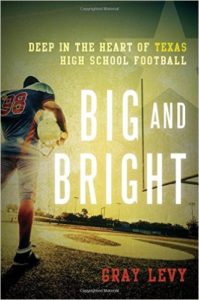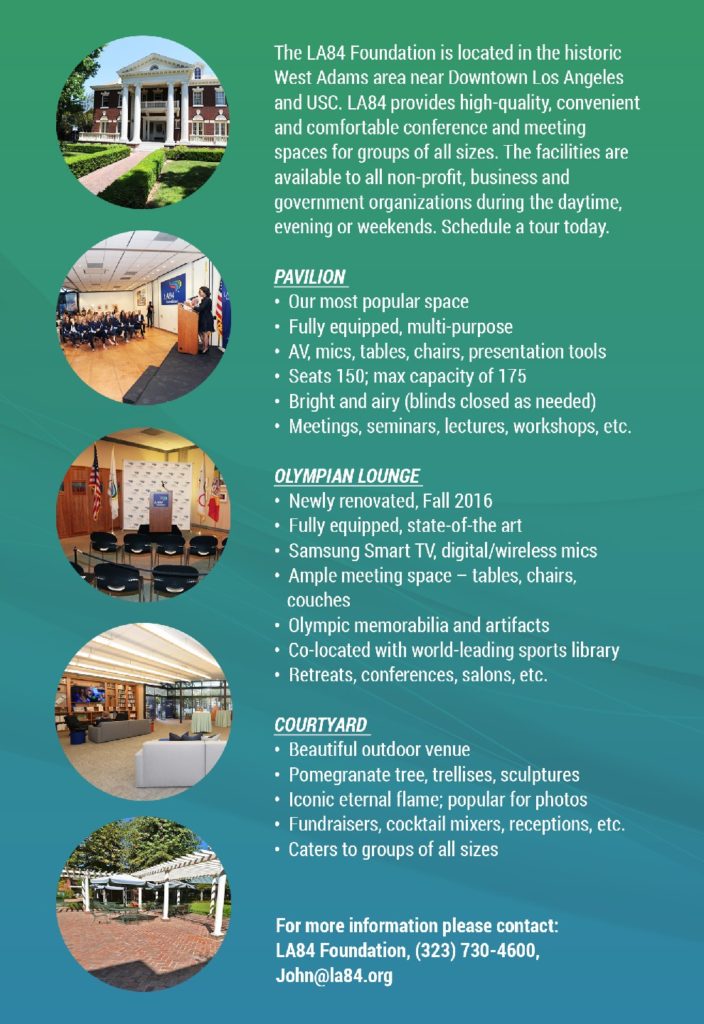SL Interview: The State of Texas Football with Author Gray Levy
 When veteran coach Gray Levy found himself “disillusioned with the changing priorities of public education” at the local school system in Nevada, he decided to take a road trip. In August of 2012, Levy loaded up his Ford Focus, said goodbye to his family, and drove to Texas. He brought along a cooler, laptop, notebooks, camera, video recorder, audio recorder, and clothes.
When veteran coach Gray Levy found himself “disillusioned with the changing priorities of public education” at the local school system in Nevada, he decided to take a road trip. In August of 2012, Levy loaded up his Ford Focus, said goodbye to his family, and drove to Texas. He brought along a cooler, laptop, notebooks, camera, video recorder, audio recorder, and clothes.
Levy spent an entire season watching high school football in Texas, including the state championships at AT&T Stadium in Arlington, where the Dallas Cowboys play their home games. He put nearly 20,000 miles on his Ford Focus, crisscrossing the immense expanse to spend a week with 11 different teams, ranging from large high schools in big cities to tiny schools in rural communities. He saw football played inside stadiums that could have doubled as cathedrals to the sport and at places so small they only field the six-man version of the sport.
In “Big and Bright: Deep in the Heart of Texas High School Football” (Taylor Trade Publishing), Levy recounts his five-months-long odyssey. Like Buzz Bissinger, who wrote about the coaches and players at Permian High School in the classic book “Friday Night Lights” (1988), Levy discovered a culture very different from the one he was accustomed to. Unlike Bissinger, Levy was enthralled by these differences. The system in Texas “has its flaws,” he writes, but he “came away convinced that theirs is the best system of public school athletics in the country. . . In Texas, athletics are as integral to the educational experience as algebra or English. Coaches are viewed as professionals . . . and are valued.”
SportsLetter recently spoke to Levy by phone from Houston, Texas, where he was watching this season’s slate of the state’s high school football playoff games.
–David Davis
SportsLetter: You went on the road in 2012 after coaching high school football in Nevada for over 20 years. What made you decide to write a book?
Gray Levy: I was the head football coach at Wooster High School in Reno. That was my last job before I did the book. To make a long story short, I got into an issue with my principal. Those things don’t generally end well for the coach, and mine didn’t. They didn’t give me the support that I needed to make the program successful. It wasn’t about wins and losses. I wanted to do some things to make it more successful, and they wouldn’t get on board with it.
It really demoralized me about coaching in Nevada. The fact is, coaching is a job that people work very, very hard at. You put in tremendous hours. In most places in the country support from the administration, and from the community, has gone downhill. As coaches, we have a tendency to think that what we do is very important. It’s tough when you realize that the general world doesn’t feel the same way about what we do.
SL: Why did you pick Texas to write about high school football?
GL: Texas was fascinating to me because I knew some coaches from down there. It seemed like a place where there still was a lot of support for coaching high school football. So I came down here looking, at first, for a job. But the fact is, with my family situation as it is – I have too many roots in Reno – that wasn’t going to happen. But I just became fascinated by the whole scene in Texas, and I was looking for a way to explore it further. That’s when my idea for the book came along. It gave me an opportunity to get enmeshed in the whole culture of high school football in Texas.
When I visited Texas the first time, I visited generally big suburban programs. But I kept hearing stories about programs in the Rio Grande Valley and in small towns, and I realized that I found that interesting too. I wanted to see the whole gamut about what high school football in Texas is like in different places and get a cross-section of teams to research and study and write about. What’s it like in a largely Hispanic community? What’s it like in a town that has 400 people? How’s that different from a place that has three or four thousand people in the high school? That turned into the eleven teams that I followed in the book.
SL: What did you know about high school football in Texas?
GL: I heard stories. I knew that athletics were really important. I knew that the participation rate was much higher. I knew they had much better facilities. Everybody knows about that. Look, Texas often gets a bad rap for being overly committed to football. People say, “Isn’t it terrible what they’re doing and how they’re putting all these resources into their football programs that would be better used in other places.”
That was the whole theme of “Friday Night Lights”– that the priorities of the school were out of whack. Maybe they were. I wasn’t there at that time. As a coach I thought that that was a cheap and easy response. It’s a different thing to see first hand than just hearing about it.
SL: What did you find that is different in Texas than in other places?
GL: The most obvious difference is something you can look at: the stadiums. You can see them from airplanes. But once you get used to the stadiums, that fact that they’re playing in bigger, fancier stadiums doesn’t really have an impact on what happens in the lives of the kids.
Obviously, the facilities are outstanding. In typical high schools they’re better than college facilities in a lot of the country. One thing I point out in the book that I think is important is that almost in every case the money that is used to build these facilities and to pay for these facilities doesn’t come out of general education funding. It’s not like, well, we’re going to either give the school math books or build a new football stadium. It’s usually a bond issue that the residents of the community voted for and passed. They don’t see it as an embarrassment to have a gigantic scoreboard or whatever. They see it as a civic touchstone that will draw people to their community.
What is acceptable in other places when it comes to athletics just isn’t acceptable in Texas. I don’t know if that’s a right or a wrong as much as it’s a cultural thing. People in Nevada would look at, say, Shotwell Stadium in Abilene and see an amazing palace to high school football. Their jaws would be dropping if they saw this place. People in Texas look at it and see a stadium that needs to be upgraded.

SL: You write that coaching is considered a profession in Texas. What do you mean by that?
GL: Athletics in Texas – including football – are co-curricular, not extra-curricular. If you’re a high school athlete in Texas in football or any sport, your class schedule is going to have football or whatever sport you’re involved in included along with math and social studies and English and other academics. You will have, say, fourth period in football or golf or volleyball. Not only will you have that class, you’re going to have that class with your coaches. They’re all involved because they’re on campus every day all year.
In Texas there is no separation between academic education and athletic education. Every coach teaches in the school. It’s part of their job. So, if you’re a math teacher and a coach, instead of teaching five periods a day of math, you’re going to teach four periods a day of math and one period of football. You’re also going to get extra teacher pay. It’s respected and worked into their schedule. They’re connected with their kids in a way that is unique.
In Nevada and the rest of the country, coaching is an after-school activity. So, basically, if you’re a teacher and a coach in Nevada, as I was for 20 years, you’re not given any allowance in your teaching schedule to help you out with your coaching. You basically sign on to put in an extra 30-40-50 hours a week during the season, for an extra $2,000. That’s what you’d get for being a coach. You get a small stipend, but there’s very little incentive to coach. Maybe volunteer coaches come in and wear the uniform of the school. In reality, they’re not really part of the fabric of the school.
SL: Will this “athletic period” ever disappear and, if it does, what will it mean in Texas?
GL: That would mean Texas would become just like everywhere else in the country as far as athletics go. I think that would be a tremendous shame. Texas has a tremendous level of support in the community, where football is very important to the general population, from youth football to the NFL. That’s true in other places, of course, but what is unique in Texas is the strength of the coaching lobby. The Texas High School Coaches Association has over 20,000 members. They pay dues and they have lobbyists in Austin. And so, any time there’s talk about trying to save money by allowing for off-campus coaches, the Texas High School Coaches Association has successfully fought that. I hope they continue to fight it successfully.
SL: You write about football being uniquely important to the culture in Texas. What do you mean by that?
GL: I found that to be most true in the small towns. But it’s also migrated to the big cities because a lot of the big-city people in Texas originally came from small towns. And, in the culture of the small towns, high school activities have an importance that I haven’t seen in other places. It is a civic virtue in small towns in Texas. You may not even like football personally, you may or may not have a child or grandchild involved with the local high school, but as a resident of Stamford, for instance, you are expected to support the high school. Football’s the activity that gets the most attention, but it’s also true of everything. They go to the baseball games. They go to the student plays. They go to the track meets. They take a lot of pride in how their marching band does in competition, in how the debate team does.
SL: What about in the summer? Is football a year-round sport for youth in Texas?
GL: I think the trend in year-round sports is a terrible thing for kids. And I think football is the one sport that hasn’t bought in, at least compared to baseball and softball and volleyball and basketball. Every single football coach I dealt with in Texas pushed playing other sports for their kids. Track is practically required for the spring. That football athletic period that I talked about basically turns into track period at most of these schools. Obviously, this benefits football as well, but there is no spring football season. The kids are encouraged in all these programs to do other sports.
The quarterback at Stamford I wrote about [Hagen Hutchinson] was the star basketball player in the winter. In the springtime he did baseball and golf and track – all three. He would go to three practices in the spring. I think being involved in multiple activities is a great thing for the kids, and most of the coaches do too.
SL: What was it like for you to visit 11 different programs in 11 weeks?
GL: I’ve been around a lot of programs. I’ve coached at five high schools myself. I’ve seen different ways of doing things, so I know there are different ways to coach. Doing it week to week, with 11 programs was really interesting. These were all successful programs, and they all had tremendously different philosophies in how they did things. Different offensive schemes, different defensive schemes, different coaching styles.
Coaches are generally very open. The stuff about hiding playbooks and stealing playbooks – it’s not really true in the real world. You can go to coaching clinics every year and the coaches will open up their playbooks to you and give you copies of their playbooks. Hudl [software for sharing game and practice video] has every play available on the computer for coaches to share. But, as coaches, we’re usually working at the same time. You go to clinics every spring and you might spend two or three hours listening to a coach, but beyond that you don’t really have a chance to go in-depth. So, this was great to be able to be a fly on the wall for an entire week at these different programs.
SL: What difference did you find between football programs in affluent schools and less affluent schools?
GL: The biggest problem with the high school system in Texas is how differentiated it is between the rich and the poor in the school districts. The inner-city school districts – and I don’t mean just the poor areas, I mean the gigantic school districts in places like Dallas, Fort Worth, Austin and Houston – have awful programs by Texas standards. There’s just no way they can compete. A good coach won’t go to those schools because they know it’s a dead end and that they’re never going to succeed. They don’t have anything like the facilities that I was describing. The rich schools are the ones that travel. The poor schools never do. It’s a gap that can never be closed.
It seems like a truism: the bigger the school system is, the more likely it is that it’ll be a mess. You don’t see large, multi-school districts do well. It’s true in Reno where I live and it’s true in Dallas, Texas. I saw it firsthand.
The districts that seem to do well are smaller districts that only have to deal with one or two high schools – even if they’re not that rich. Abilene High is not a rich place. But the Abilene school district only deals with two high schools. It makes a huge difference where the resources go and the priorities that are in place.
SL: The issue of concussions has become very prominent of late, including a new movie. How do the high schools in Texas handle this?
GL: Texas policy is very stringent, and they’re probably at the forefront for making sure that their kids are protected. That’s because of the infrastructure. Every Texas high school at the 3A or above level has two full time trainers. There’s always a trainer at every practice or event. Since they’re full time, they also teach a class in athletic training, so there are usually 10 or 15 student trainers running around that are all trained in CPR and lifesaving techniques.
With concussions in Texas, there’s a law where the trainer has the ultimate say about whether a player can play or not. If the trainer has reason to think there’s a concussion, the kid’s helmet will be taken away and the coach has nothing to say about that. That’s probably true in most states these days. But in Texas the trainers are probably better qualified than in most other places and they’re more prevalent. You see a lot more of them. That’s not true where I came from. In Nevada, the trainers are volunteers and they’re part-time. And, there’s only one of them.
You mentioned the movie. My problem with the whole discussion with concussions lately is that it always goes to the Junior Seaus of the world. It always goes to NFL players that played the game at the very highest level for upwards of 20 years. The human body is not designed for football, period. That’s why it’s a game that’s played once a week. Just like boxing or any other physical activity: the more you do something, the more risk you put yourself in.
What gets lost in the concussion argument is that the vast majority of football players only play for three or four years. If you play for 20 years, against the very best people in the world, chances are very good that you’re going to get brain injury. But that is not the norm for your typical high school football player. Don’t get me wrong: there are risks. But there are risks for riding a bike.
Can the game be made safer? Absolutely. There should be an effort made to make it safer. But I don’t believe that the danger is so great that the game needs to be abolished or outlawed. There are a lot of outstanding benefits to playing the sport.
SL: “Friday Night Lights,” by Buzz Bissinger, is the book that most people associate with high school football in Texas. What is your opinion of that book and how did your experience compare and contrast with Bissinger’s?
GL: I loved the book. It was a fascinating read. I read it when it first came out, and I probably read it in one sitting. He’s obviously a much better writer than I am. But he’s not a coach, and he went in with a different agenda. He focused on the negative. I don’t think it was quite fair.
Bissinger spent quite a bit of time talking about athletics getting in the way of academics and how kids were so focused on football that they didn’t have the time or the energy to study. As a coach for a lot of years, I’ve heard that kind of thing before. Kids will often come to you and say they’re going to quit football because they don’t have time to study. Most of the time, when a kid tells you that and they quit the game, their grades get worse. I’ve seen it repeatedly.
For every kid that says their grades suffered because of football, I can find 10 kids who did better because of football. And, this applies to any sport or activity. It teaches them time management. It teaches them discipline. It teaches them skills that help them in the classroom. We know what happens to kids when they stop playing football or other sports. Invariably they do worse when they lose that anchor and that support and that discipline that it takes to be involved in a competitive athletic program.
SL: What are you doing now? Did you return to coaching football?
GL: Being in Texas and researching the book was great, but I missed coaching. I went back to coaching in Reno as an assistant coach. It was really tough at first because I was so used to how they did things in Texas. I’ll probably never be a head coach again in Reno because I just can’t go back to having so little support. I think it’s unfair and I’m not willing to deal with that again.
This last year I was an assistant coach at two places. One was a high school in Reno in the fall. My spring situation was different. I got a job as offensive coordinator for a semi-pro team in Ravensburg, Germany – way down South near the Swiss and Austrian border – from March until July.
They have a lot of American football in Germany, and they’re desperate for coaches over there. I found the idea of football in a foreign country to be fascinating. It’s such an American thing. Like with the Texas scene, I found it fascinating to experience football in a different culture. So, I’m probably going to do a book like “Big and Bright” about football in Germany next.




